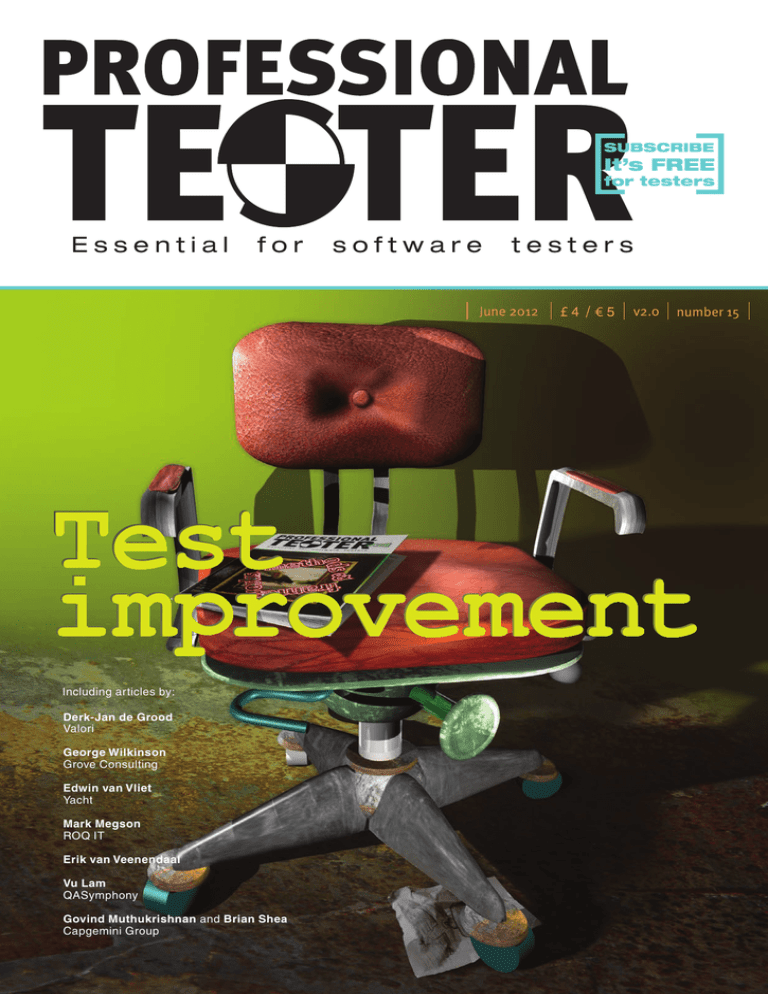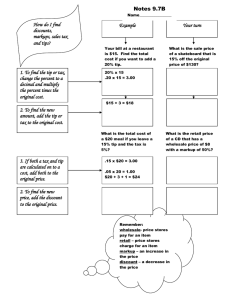testing in production
advertisement

TE TER SUBSCRIBE It’s FREE for testers Essential for software testers June 2012 £4 /¤5 v2.0 number 15 Test improvement Including articles by: Derk-Jan de Grood Valori George Wilkinson Grove Consulting Edwin van Vliet Yacht Mark Megson ROQ IT Erik van Veenendaal Vu Lam QASymphony Govind Muthukrishnan and Brian Shea Capgemini Group Test improvement TiP and the iceberg by Derk-Jan de Grood More testing in production is inevitable, but that's not as bad as you think Derk-Jan de Grood thinks pragmatic acceptance will pay off For most of my career I have believed in DTAP (development, test, acceptance and production done in that order). In this article I will argue that pressures on that model are now too great and it is necessary to move to testing in production (“TiP”). For many PT readers and its editor this is a nightmare become real, but it is time to put doomed, even if valid, arguments aside and be pragmatic. Environmental dependency Standalone systems are now rare. SOA enables powerful applications but makes them very hard to develop and even harder to test outside the production environment. Embedded software, ie that very closely integrated with specific hardware, firmware and/or connectivity, poses a similar challenge. Simulators can be used to support certain techniques 4 PT - June 2012 - professionaltester.com such as state transition testing, but in most cases “end-to-end” testing, although certainly necessary, is not done creating dire risk. Testing must seek ways to put a stop to this. Appification and device diversification The proliferation of small, cheap applications used to perform specific tasks has changed the expectations (and sometimes needs) of stakeholders and users, making them less willing (and sometimes less able) to wait for solutions via restricted channels. Application managers and IT departments still raising support tickets with vendors, locking down workstations, enforcing policies and privileges and so on are being bypassed and undermined by user groups taking initiatives themselves. Homebrew spreadsheets and databases which won't scale or are disabled by external events such as migration have always been a problem. New generations of cloud applications, bring-your-own-device working cultures and multiple configurations (including location-dependent ones) will be far worse. Testing needs to address these problems and the only way to do that is to get involved where they arise: in production and operations. Continuous integration and deployment Rightly or wrongly, and opinion is mixed, development cycles continue to get shorter. Continuous integration makes development work very flexible, making it easier for it to serve the business better – if there are no severe defects. But CI makes the testing needed to assure that harder. It creates a stark choice: perform good, repeatable end-to-end tests against obsolete test items or weak atomized development tests against the latest test items (called by some “continuous testing”). Testing needs to create a third and preferable option: to be able to Test improvement execute end-to-end tests against the current production system. TiP techniques Several approaches have been suggested, some of which some are already in widespread use having evolved for various other but often related reasons. Seth Eliot provides a very useful annotated list in his article in The Testing Planet (http://thetestingplanet.com/2011/11/thefuture-of-software-testing-part-one-testingin-production). Many of them are variations of “beta” or “crowd” testing, involving groups of users performing nonsystematic tests, or ways of gathering results from that. This can detect defects that would otherwise be missed, when a user is in a localized situation that could not be simulated (or more likely would not be thought of) in “laboratory testing”. However there are obvious dangers in relying too much on users rather than testers. Other techniques include “destructive testing” (deliberately injecting infrastructure defects to show that the test items behave as expected with them present) and “synthetic testing” (generic "write once, use anywhere" tests executed in both development and, often using API-level monitoring to observe results, production). Prerequisites for TiP All empirical testing aims to assist risk management by detecting defects but TiP, like any kind of testing, cannot reduce risk by itself. Detecting a defect which then still causes a real user to experience failure is of no benefit. Preventing that requires two things. First, making, deploying and validating fixes must happen very quickly. Although I have cited CI, because it makes pre-production testing difficult, as a reason for doing TiP, the whole truth is that TiP requires CI. “ramped” deployment. What is needed to make it possible must be considered very carefully during all design activities. Users cannot be expected to notice, let alone report, important incidents as effectively as testers. So their work must be supported by informative error messages and automated reporting facilities presented via the user interface of the application under test and integrated monitoring (also needed for many TiP techniques not involving users) which works independently of the user. I expect that more functionality will be added to applications specifically to support TiP: for example, to help and incentivize all end-users to report defects well. This might grow to work in similar ways to today's social media applications. In pre-production testing it's often necessary to use production data, then to be able to separate from it data created or modified by executed tests in order to observe test outcomes. That can be difficult but is usually possible by a combination of disciplined, well-managed test inputs and the use of comparators. Having done it, the changes (including any not observed) can usually be reversed for further testing purposes simply by reverting to a “clean” copy of the production data. But imagine a situation where the possibly dirty version must be put back into production, replacing the production data never touched by testing! That is the situation TiP creates and when the “beta” techniques described above are used it is impossible to manage the test inputs. To avoid terrible danger of testing causing failure in production, the separation needs to be done not by testers or DBAs after the event, but by the application under test at the time of test execution. Therefore in non-trivial projects TiP typically requires advanced “design for test” work to be incorporated into development practices, code, data structures and even system architectures. That, I think, is the future of TiP. Other disciplines will be far more involved in testing and testers will have to help them. The authorization matrix will change therefore so will security and auditing policy. Everyone will need much better understanding of not only what to do but why it is done. The need for early, accurate, well-communicated test strategy, planning and design will be multiplied. Furthermore, although TiP moves some testing to post-production, it is highly dependent on the pre-production testing which remains and is ineffective and dangerous if that is not done well: it requires continuation and renewal of the diligent search for and application of techniques for analytical testing in parallel with development. What we see now is the tip of an iceberg: until architecture and development themselves change radically, there is no alternative to TiP so it is set to grow and evolve in unexpected ways. I believe it will create much more, not less, need for professional testers Derk-Jan de Grood is a test manager at Valori (http://valori.nl) and a published author and frequent speaker on testing. His latest book in Dutch, Grip op IT - De held die voor mijn nachtrust zorgt (Academic Service, ISBN 9789012582599) is available now. This article is related to a chapter of a forthcoming book on the future of testing in which he and co-authors will aim to help fellow testers anticipate coming needs and demands, sustaining happiness in their work and the value of the testing profession. Details when available will appear at http://professionaltester.com Secondly it must be possible to deploy test items for use only by defined groups of users, while other users either continue to use other versions of those items or are not offered functionality that depends upon them: this can be called “phased” or PT - June 2012 - professionaltester.com 5




